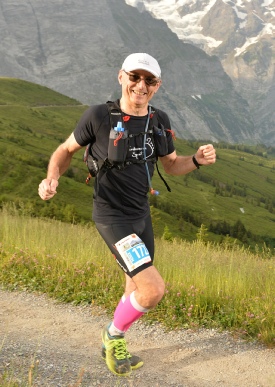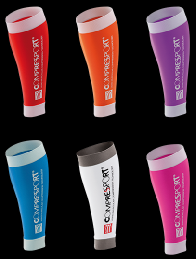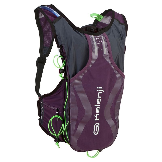












Gentle Running and Living
by Dr Patrick Salmon, PharmD, PhD
Member of the Barefoot Runners Society
Founding Member of the Tarahumara Spirit



Be gentle
to yourself
and others!
“Life is hard enough to add extra suffering to it”. We propose here a way to build a stronger, healthier and happier self through gentle running. Then, this “ascetic hedonism” can be translated into several aspects of life, to humbly contribute to a better world.

You can help your fellow humans and the world in general by sharing this site and its links.
You can join me at this email: drbarefootpat@gmail.com

Version française (en construction) à ce lien.


My blog
Under construction
Here is a guide from a Master, Scott Jurek, about the spirit of Trail Running: Good posture, relaxed and tall, controlled falling, ease into it!
How I trained for my 3rd Eiger Ultra
First, to avoid injuries and get maximum efficiency
with minimum effort, you need to run NATURALLY.
The Basics of Natural Running are described in the “Basics” pages of this site. To make it super short, if you want to run long distances, if you want to run even at old age, and if you want to have fun running and stay away from injuries, you need to run NATURALLY. This means no braking (heel-strike), no shock (smooth landing), no push (no back leg trailing behind. You just want to master the principles of easy, smooth and efficient running. Just ease into the trail, by letting your hips guide you. Just lean forward from the ankles, and put your leg under your center of mass to keep yourself from falling. This is well described by Scott Jurek (the Master) in the Youtube movie on the right (from minute 4 to 6). Focus on staying tall and relaxed. Your pelvis must be totally relaxed and will gently guide you forward.
In Qi Gong, this can be viewed as trying to keep a perfect alignment of Bai Hui, Governing Vessel Meridian Point 20 (at the top of the skull, i.e. our connection to the sky), Guan Yuan or Dan Tian, Conception Vessel Meridian Point 4 (where the Qi originates and is stored in the human body, i.e. in a ball between the navel and the pubis), and Yong Quan, Kidney Meridian Point 1 (a tad in front of the middle of your forefoot, where the human body connects with the Earth. In Qi Gong, Natural Running all makes sense since you will just follow your Qi center (basically your pelvis) while keeping it aligned with your connections with the Earth and the Sky. As a bonus, also according to Qi Gong, you must keep two points totally relaxed. This is the middle of your palms, Lao Gong, Master of the Heart Meridian Point 8, where the Qi enters the body, and the zone connecting your neck and your shoulders, Jian Jing, Gall Bladder Meridian Point 21, which connects to Yong Quan, to optimize relaxation and efficiency.
2nd, build yourself strong feet, ankles and legs.
Again, the goal is to be as strong as possible to prevent injuries. It is also crucial to be truly efficient. I do it by running at least 2 times a week, one hour in sandals. My sandals are Huaraches from Xeroshoes, the Contact version (6 mm). When you run with these “shoes”, you learn how to caress the Earth so that you do not make any sound (actually a little bit, but you will avoid the annoying loud flapping sound). That way, your legs and feet learn how to absorb the impact to the max, to be able to store its energy and give it back as a spring. If you make too much sound, that is the sign you are too fast for the fitness of your legs or feet. Slow down until you have a soundless stride and humbly progress from there. You will discover that your feet are full of little muscles, tendons, ligaments and bones, that you barely used with big shoes. By building yourself “real” feet, they will get so strong that your chances of injuries are very low. Also, you must practice on uneven grounds to work out the lateral muscles, tendons and ligaments.
3rd, practice a little bit of true barefoot.
At the end of each 1 hour run, if weather permits, take off your shoes and run barefoot for 5-10 minutes on smooth pavement. It can also be 3 to 5 laps on a race track. The surface must be reasonably smooth, not too hot, not too cold, not too wet. Avoid sand, grass or nordic trails, they are too soft and thus useless, and also dangerous because you cannot see what is inside. Running barefoot on smooth hard surface will be the perfect teacher for good form running. The sole of your feet is covered with sensors that will tell you instantly if you do it right. If you brake or if you push, or if you land too hard, you will feel it. This is the best teacher of natural and efficient stride, just because you are forced to run GENTLY, hence efficiently. You can see of the video on the right, the sequence of impacts of Natural Running: External Ball of the Foot, then all the Forefoot, then the heel, then the Achilles tendon and the calf muscle stretch and finally you lift your foot. Running barefoot will also recruit PLENTY of muscles, tendons and ligaments that are almost never used in your foot, because modern “running”shoes act on your feet as casts, and prevent them to function normally, if at all. So you will also discover plenty of sore spots as your feet start this re-building process. Again, be patient, be gentle and progressive. You are building yourself real feet during this process and you will never regret it. Finally, try to run minimalist and smoothly on uneven terrain, since this the best trainer for your feet and ankle to adapt to angular stress (strengthening of muscles, tendons and ligaments from the toes to the knees.
4th, set up a baseline of 2 one-hour sessions of
Natural Running per week.
Whether it is cold or hot, you feel tired or too busy, it is raining of snowing or hailing, go out with the proper gear and run at a comfortable pace (do not try to beat the time of the last run, but do not jog like a slug). Practice all the items of Natural Running (Posture, Cadence, Kiss and Lift, Small Smooth Silent Strides, Glide from the Waist), with maximum mindfulness. Try to make each stride better and smoother than the one before. If you practice this with as minimalist shoes as possible (Huaraches are best, then, Merrell Pace Glove, then Merrell Trail Glove), your feet and legs will get super strong and springy and thus super efficient. You will get closer to maximum efficiency and further from risk of injury.
5th, on weekends, start to put up time, mileage and ascent (D+)
The goal is two-fold. First, you want to train your body and mind for long lasting efforts, find your best pace for that and also test equipment and re-fueling routines for these long runs. Second, you will train different muscle groups that are barely used on flat terrain (mainly the quads and all the tendons and muscles around your knees), because that is the descent that is new to your body. Climbing up is hard mainly for the cardio. You have make a compromise between speed, suffering and not to cook yourself to be able to resume running as soon as gets flat again. But descent requires a lot of muscles on the front of the legs, together with new motor skills to land smoothly, choose the right spot to put your foot, keep your balance as well as the spring and the cadence. It sounds like it needs a lot of practice. Yes, it does. A lot! But the good news is that you can train for a long trail with a work and family schedule: 2 shorts sessions in the week, one big outing on the WE.
Now, here is how I trained for my last E51 in July 2015
(51 km, 3200 m D+).
For this goal, I prepared from March to July (E51 is mid-July) with a progressive increase of WE runs in mountains, one every week-end, until I reached 2/3 of the expected race effort around 3-4 weeks before. In my case for the Eiger E51, I train up to a Sierre-Zinal type of run, i.e. 32 km and 2100 m ascent.
The 1st mountain run of the season must be short, less than 10 km and less than 1’000 ascent, i.e. around 2 hours of exercise. Each time, apply the Easiness and Gentleness Spirit. You want to push yourself a bit further than you feel comfortable in terms of intensity and length in order to get stronger. But you want to avoid injury or burn-out. The days after, you must feel some soreness in the muscles, but not too much, and for not more than 2-3 days. That is how you get stronger without injury or over-training.
Allow yourself plenty of sleep and recovery time. Otherwise fatigue will accumulate and you will get weaker until your burn out from over-training. And that is not the point at all!!!
Check this link. Follow your sensations. Your training buddies may be faster and stronger. Do not try to compete. Remember your goals: Getting stronger and finish the Race with a big smile. If you cannot recover fully after 2-3 days, while keeping the 2 sessions in the week, stay with the previous load. Once, you can recover fully, increase the WE mountain run to 3 hours, i.e. 15 kms and around 1400-1500 m ascent. Again, follow the same principle during and after the run.
Then, go to 4 hours, and increase by a one-hour increment, until you reach at least two thirds of the race metrics. For me, it was 6 to 8 hours with 2000-2500 D+, one month before the race. If you trained progressively and gently, you should not feel any muscle soreness the days after, because you are now strong enough everywhere. You may just feel a tad tired for 2-3 days with no big motivation to go running again on flat terrain. No problem. Either rest, or bike, or swim, or do a few laps barefoot, slow and easy.
My Gear
From top to bottom, here is my current gear for training and “racing”.
- The cap: Crucial! Gore Running, white. White because when it is hot and sunny, it is cooler than any other color, especially black. The cap also because it covers the head, and if you have low hair density and/or super short haircut, you will not get sunburn on your scalp. A cap because when it rains, whether you wear glasses or not, you won’t get rain in the eyes. Gore Running because it can accommodate most skull, including large, wide and cubic ones like mine thanks to it scratch on the back. Gore Running because it has a nice sponge ribbon on the forefront so that people sweating a lot won’t get sweat across the eyebrows into the eyes. You can see sweat dripping from the outer edges!
- Glasses: I am near-sighted since the age of 12, and now with age I am also long-sighted. So without special glasses, I can focus only between 10 cm and 30 cm. So if I want to see the scenery and read my GPS or smartphone, and adapt to light or dark, I now wear special prescription glasses with auto-shade.
- T-shirt: Anything breathable and light. Light color is better in hot and sunny weather, for the same reasons as above for the cap.
- Backpack: That is a tough choice. Light or roomy? I started 2 years ago with a “big” one, Raidlight, see the red one in the picture on the right. At that time, I was intimidated by trail running, and I did not want to miss anything when on the trails for long distances with no experience on refueling. So I went for the big American SUV option with plenty of room and pockets. This year, as I discovered that I could run in mountains trails in sandals and without poles, I decided to go “light”, so I bought the Kalenji model on the right. It is big enough to put a 1.5 liter water bag, extra clothes, a 500 ml bottle, my smartphone, plus extra food and powders.
- Pants: Now I wear short pants. Make sure that NOTHING rubs your skin, between the legs, genitals, etc. After 10 hours of rubbing, even thigh against thigh, especially when wet, the skin will come off. So test your pants, and check they are very tight and adjusted. I now wear Skins XS size. And I put plenty of Akileine NOK cream all around the genitals, the upper inside of the thighs, and the nipples.
- Fluids: Since I sweat a lot, I need to carry a lot of fluids, and also make sure that I have enough electrolytes (salts) on board. In the backpack, I have a 1.5 liter waterbag (Source) that I use to prepare my sports drink. To make it on the go, I carry small zip-bags with pre-weighted powder to make 1.5 liters each time. The powder is a 50-50 of Ergysport Effort and Ergysport Regen. It has all the ions you need plus BCCA, vitamins and oligo-elements, and a tad of carbohydrates. I also carry an extra 500 ml bottle with just water. This is to rinse off when I am tired of sucking the sports drink, and also to have an extra autonomy when I run out of the sports drink and before I reach the next re-fueling station.
- Food: I usually carry 3 to 5 gels or bars, plus some dried fruits like figs and apricots. The rest I eat in re-fueling stations (bread, meat, anything).
- GPS watch: When you spend hours in the mountains, you need a watch that has good autonomy and a nice GPS capability. The Suunto Ambit 3 Peak has it all, plus it is shock resistant.
- Smartphone: Always! It is mandatory in races, and also when training you can find your way with GoogleMaps. And you can take pictures. And you can practice the proper cadence using a metronome set at 180 beats per minute. I put it in a small plastic bag for when it rains. I also carry an extra battery and a cable to recharge in case.
- Compression socks: I noticed on my 1st long trail (Eiger 2013) that I get oedema in my calves and feet the days after the run. Now I used Compressport R2. They come in nice colors and are very effective. No more oedema even after more than 11 hours of running in hot weather.
- Socks: X-Socks Speed One. When I wear shoes of course.
- Shoes: Last race was in Skechers Gobionic Trail. Zero drop, 6 mm stack, nice lugs with good grip even on wet rocks. Super flexible so the foot can move naturally, and super wide toe box, so my toes can spread and my toe nails do not become black even after 11 hours of running. But, they start to show wear in the fabric and Skechers stopped this model so I will try new shoes this winter, including Merrell Trail Gloves 3, Merrell Vapor Glove 2, Vivobarefoot Trail Freaks, etc.
- Poles: Since I have a bad balance and below-average motor skills, I kept falling during my two first years of mountains trails. Sometimes very heavily. So I used my poles to help me keep my balance by using them as 2 extra limbs, especially downhill. But this year I discovered incidentally that I could go in the mountain in sandals for 1000 to 2000 m D+ without poles. The secret, again, is short steps and high cadence. This way, I stay springy and aware, being careful of each step. This helped me a lot to gain confidence, balance and strength in the legs, so I could complete all my trails in 2015 without poles.
And here is a video that shows how running in general, and trail running in particular, should be. Short strides, high cadence, no heel-strike, just plain smooth and easy. Glide, don’t fight!








The “girl” version is really nice


Quelques conseils de trail en français